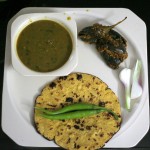
Panjabi Food-Choices In The Diaspora
In an effort to better understand the food habitats of Panjabi immigrants, Canadian researchers conducted a three-year study on the ingredients used in daily Panjabi meals and food choices made by Panjabi families.
Gwen Chapman, study leader and British Columbia University nutrition professor, stated:
“Since cardiovascular diseases and type II diabetes are more prevalent among Indians and they are linked to food habits, we wanted to understand what ingredients went into daily Punjabi or Indian meals.”
An important part of study was also understanding how cultural affiliations play a role in Panjabi immigrant food choices.
Researchers found that “in Punjabi families in British Columbia … separate meals are often prepared to accommodate elders who need traditional roti, daal and subji, and younger family members who prefer to balance Indian and “Canadian” foods.”
While reading this article I thought about how these food choices actually play out in immigrant Panjabi homes across North America. I remember the rotis without butter for those who have high cholesterol and the weekend meal of burger and fries for us “American” kids. There were also the interesting “masalaa” pastas, lasagnas, and pizzas that had a “Panjabi” twist (i.e. tons of garam-masalaa). I recall uncles’ refusing to eat “kaa-foos” prepared by their wives, aunties making tofu-sabiji, and mothers’ substituting olive oil for vegetable oil when making tarkas. Many of these food choices were an effort to provide more healthy meals as a “preventive” form of action against heart disease and diabetes; while others were made to satisfy taste-buds.
So I was wondering what interesting food choices have you seen Panjabi families make in the Diaspora both to satisfy taste-buds and become more healthy?














Yes, using olive oil was one of the changes we made, in addition to reducing the amount of salt used in sabjis, daals etc. Some families also use wheat atta to make rotis (or a mixture of the two types of atta) as a healthier choice.
Yes, using olive oil was one of the changes we made, in addition to reducing the amount of salt used in sabjis, daals etc. Some families also use wheat atta to make rotis (or a mixture of the two types of atta) as a healthier choice.
wheat atta?
I though atta is from wheat or corn (makki)
Majority of the rotian are made from refined wheat-the healthier kind is the unrefined or whole wheat flour.
In rural Punjab, most ppl eat the whole wheat atta-much higher in fiber.
wheat atta?
I though atta is from wheat or corn (makki)
Majority of the rotian are made from refined wheat-the healthier kind is the unrefined or whole wheat flour.
In rural Punjab, most ppl eat the whole wheat atta-much higher in fiber.
you're definitely correct baingandabhartha. i meant to specify that many people are substituting the tradition refined wheat atta and using whole wheat atta instead. i have to admit, i haven't been able to make the switch yet…
you’re definitely correct baingandabhartha. i meant to specify that many people are substituting the tradition refined wheat atta and using whole wheat atta instead. i have to admit, i haven’t been able to make the switch yet…
The education system should be improved in the country. Education system is very important for the development of the society. Without the good education system no one can able to make the country strong and developed.